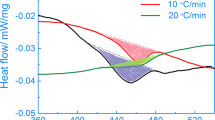Abstract
USING an improved X-ray technique, Preston1 and Guinier2 have shown that when aluminium-copper single crystals containing 4 per cent copper are aged at low temperatures, thin plates of copper-rich atoms are formed on (100) planes of the crystal. Swindells and Sykes3 found, from specific heat measurements on a similar alloy, that when specimens previously aged at low temperatures were re-heated, heat was absorbed before the chemical energy of precipitation was liberated. They suggested that this energy absorption was due to the dispersion of the copper-rich plates formed during the low-temperature ageing, an interpretation which was confirmed by Preston.
This is a preview of subscription content, access via your institution
Access options
Subscribe to this journal
Receive 51 print issues and online access
$199.00 per year
only $3.90 per issue
Buy this article
- Purchase on Springer Link
- Instant access to full article PDF
Prices may be subject to local taxes which are calculated during checkout
Similar content being viewed by others
References
Preston, Proc. Phys. Soc., 52, 77 (1940).
Guinier, C.R., 206, 1972 (1938).
Swindells and Sykes, Proc. Roy. Soc., A, 163, 237 (1939).
Barrett and Geisler, J. App. Phys., 11, 733 (1940).
Sykes and Jones, J. Inst. Met., 59, 257 (1936).
Mehl and Jetter, Amer. Soc. Metals, Preprint No. 30 (1939).
Author information
Authors and Affiliations
Rights and permissions
About this article
Cite this article
JONES, F., LEECH, P. Pre-Precipitation Phenomena in Age-Hardening Alloys. Nature 147, 327–328 (1941). https://doi.org/10.1038/147327b0
Issue Date:
DOI: https://doi.org/10.1038/147327b0
This article is cited by
-
Kinetics and mechanism of precipitation processes in Al-Ag alloys
Journal of Thermal Analysis (1985)
Comments
By submitting a comment you agree to abide by our Terms and Community Guidelines. If you find something abusive or that does not comply with our terms or guidelines please flag it as inappropriate.



